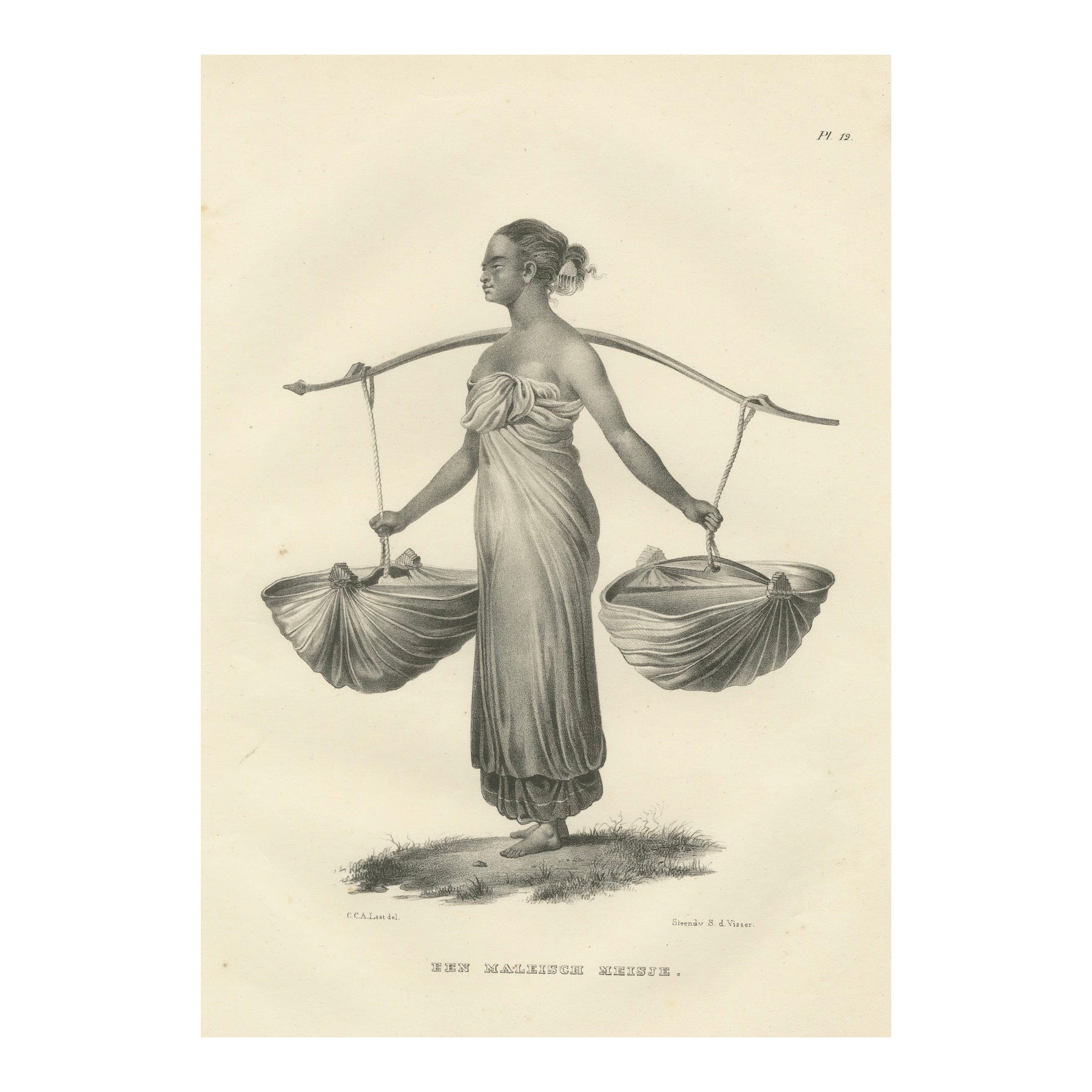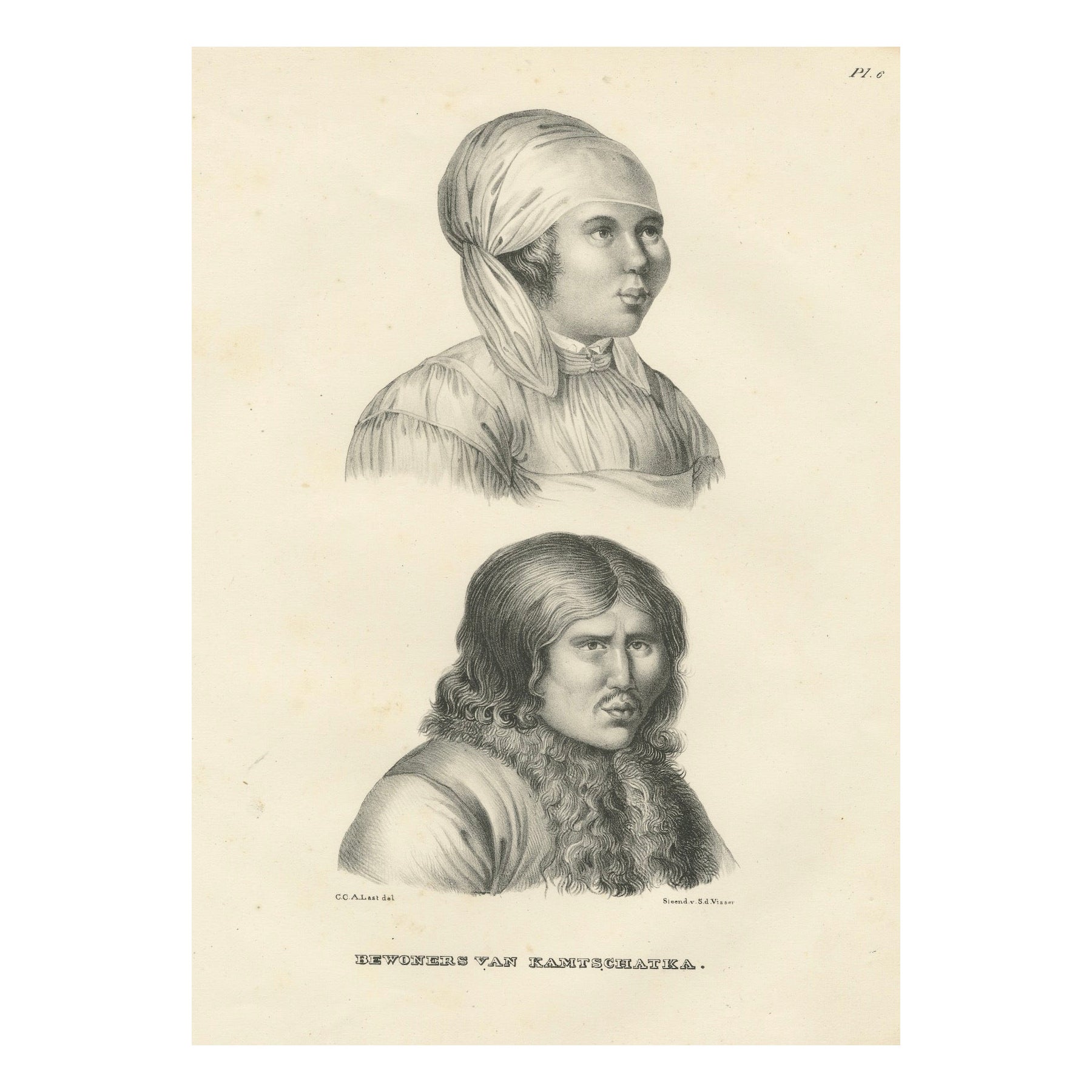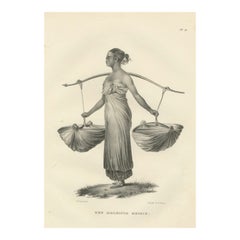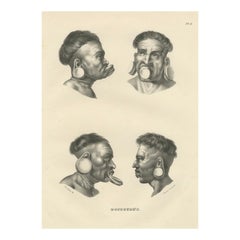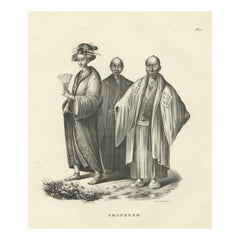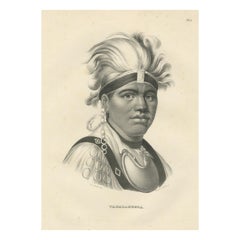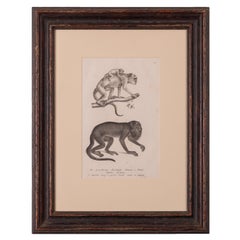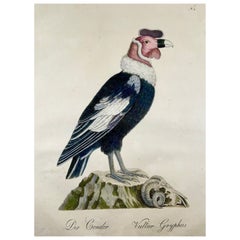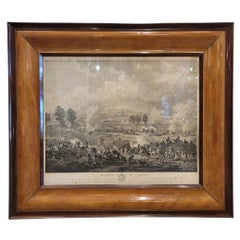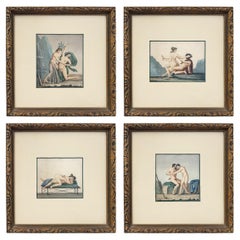Items Similar to A Tattooed Man from Nuku Hiva, French Polynesia, by Karl Joseph Brodtmann, 1836
Want more images or videos?
Request additional images or videos from the seller
1 of 7
A Tattooed Man from Nuku Hiva, French Polynesia, by Karl Joseph Brodtmann, 1836
About the Item
This lithograph by Karl Joseph Brodtmann presents a tattooed man from Nuku Hiva, an island in the Marquesas Islands, located in French Polynesia. The artwork captures the intricate and culturally significant tattoos that adorned the bodies of Marquesan men, reflecting their social status, identity, and the rich tattooing traditions of the region.
Description:
The lithograph depicts a man from Nuku Hiva with highly detailed and elaborate tattoos covering his face, neck, chest, and shoulders. Tattooing was a deeply ingrained cultural practice in the Marquesas Islands, where intricate body art represented various aspects of the individual's identity, including their status, achievements, and lineage.
- Tattoos: The tattoos on this man are extensive, covering his entire upper body with geometric patterns, circular motifs, and bands that encircle his arms and chest. The facial tattoos are particularly elaborate, forming symmetrical designs across his forehead, cheeks, and chin, which are consistent with the Marquesan tradition of tā moko, the art of body and face tattooing. These tattoos often signified bravery, social rank, and personal accomplishments. The chest is adorned with a checkered pattern, surrounded by detailed bands of tattooed designs, and the entire composition showcases the complexity and artistry of Marquesan tattoos.
- Hairstyle: The man’s hair is tied into a topknot, a traditional style often associated with Polynesian men of high status. His expression is neutral but dignified, emphasizing the cultural importance of his appearance.
This portrait not only emphasizes the individuality of the man but also highlights the broader cultural practice of tattooing in the Marquesas Islands, offering European audiences a detailed view of this intricate art form.
Maker:
Karl Joseph Brodtmann (1787–1862) was a Swiss lithographer whose works focused on ethnographic, scientific, and natural history subjects. His detailed illustrations of people from around the world contributed to European knowledge of distant cultures during the 19th century. Brodtmann’s ability to capture cultural details such as tattoos, clothing, and adornments in a realistic yet artistically compelling way made his work valuable to both scientists and art collectors.
Technique and Style:
This lithograph, like Brodtmann’s other works, was created using lithography, a method that allowed him to capture fine details and subtle shading. His style here combines ethnographic accuracy with a focus on the intricate beauty of the tattoos, which are carefully rendered to emphasize their patterns and symmetry.
The use of shading brings out the three-dimensionality of the tattoos, making them appear as if they are truly part of the man’s skin, while also highlighting the texture of his body. The portrait’s clean, simple composition ensures that all attention is drawn to the tattoos and their significance.
Cultural Context:
Tattooing in the Marquesas Islands was a central cultural practice for men, and receiving these intricate tattoos was a rite of passage that marked a man’s transition to adulthood. Tattoos in this region were not only decorative but also served as symbols of the individual’s rank, bravery, and personal history. Marquesan tattooing was considered one of the most elaborate and sophisticated tattooing traditions in Polynesia, with designs that often covered the entire body over the course of several years.
The man from Nuku Hiva depicted here must have been a person of high status within his community, as the extent and intricacy of his tattoos suggest that he had undergone many sessions of tattooing, a process that was both physically and spiritually significant.
Brodtmann’s depiction of this tattooed man provides European audiences with a glimpse into the tattooing practices of the Marquesas Islands, reflecting a broader fascination with the so-called "exotic" customs of Polynesian cultures during the 19th century. The portrait contributes to the ethnographic documentation of the time, offering insight into the complex artistry and cultural importance of tattooing in the Pacific Islands.
- Dimensions:Height: 12.8 in (32.5 cm)Width: 10.24 in (26 cm)Depth: 0 in (0.02 mm)
- Materials and Techniques:
- Period:
- Date of Manufacture:1836
- Condition:Condition: good, given age. General age-related toning and/or occasional minor defects from handling. Some stains along the right border, not affecting the image. Please study scan carefully.
- Seller Location:Langweer, NL
- Reference Number:Seller: BG-13176-151stDibs: LU3054341515852
About the Seller
5.0
Recognized Seller
These prestigious sellers are industry leaders and represent the highest echelon for item quality and design.
Platinum Seller
Premium sellers with a 4.7+ rating and 24-hour response times
Established in 2009
1stDibs seller since 2017
2,417 sales on 1stDibs
Typical response time: <1 hour
- ShippingRetrieving quote...Shipping from: Langweer, Netherlands
- Return Policy
Authenticity Guarantee
In the unlikely event there’s an issue with an item’s authenticity, contact us within 1 year for a full refund. DetailsMoney-Back Guarantee
If your item is not as described, is damaged in transit, or does not arrive, contact us within 7 days for a full refund. Details24-Hour Cancellation
You have a 24-hour grace period in which to reconsider your purchase, with no questions asked.Vetted Professional Sellers
Our world-class sellers must adhere to strict standards for service and quality, maintaining the integrity of our listings.Price-Match Guarantee
If you find that a seller listed the same item for a lower price elsewhere, we’ll match it.Trusted Global Delivery
Our best-in-class carrier network provides specialized shipping options worldwide, including custom delivery.More From This Seller
View AllA Malaysian Girl Carrying Goods by Karl Joseph Brodtmann, 1836
Located in Langweer, NL
This lithograph, attributed to Karl Joseph Brodtmann, portrays a Malaysian girl engaged in an everyday activity, likely carrying goods using a traditional shoulder pole (yoke). The p...
Category
Antique 1830s Prints
Materials
Paper
Portraits of Botocudo People from South America by Karl Joseph Brodtmann, 1836
Located in Langweer, NL
This lithograph by Karl Joseph Brodtmann depicts members of the Botocudo people, an indigenous group from Brazil. The Botocudo are historically known for their distinctive use of lar...
Category
Antique 1830s Prints
Materials
Paper
Chinese Figures in Traditional Attire by Karl Joseph Brodtmann, 1836
Located in Langweer, NL
This is a lithograph by Karl Joseph Brodtmann, from his 1836 collection of ethnographic prints. The image depicts three figures identified as "Chinezen" (Chinese), standing in tradit...
Category
Antique 1830s Prints
Materials
Paper
$408 Sale Price
20% Off
Portrait of Native American Tawadanega by Karl Joseph Brodtmann, 1836
Located in Langweer, NL
This lithograph, created by Karl Joseph Brodtmann, depicts Tawadanega, an individual whose name suggests Native American heritage, likely from one of the Eastern Woodlands tribes. Th...
Category
Antique 1830s Prints
Materials
Paper
Tahitian Grace: 1836 Engraving of a Dancer by Karl Joseph Brodtmann
Located in Langweer, NL
This lithograph by Karl Joseph Brodtmann presents a detailed portrait of a Tahitian dancer. The artwork is part of Brodtmann’s ethnographic series, capturing the attire, posture, and...
Category
Antique 1830s Prints
Materials
Paper
$408 Sale Price
20% Off
Portraits of Inhabitants of Kamchatka by Karl Joseph Brodtmann, 1836
Located in Langweer, NL
This lithograph, attributed to Karl Joseph Brodtmann, is an example of his ethnographic work, from the 1835 series. It features two individuals labeled as "Bewoners van Kamtschatka" (Inhabitants of Kamchatka), representing the indigenous people of the Kamchatka Peninsula in Russia’s far east.
Description: This lithograph depicts two portraits, a woman and a man, identified as residents of Kamchatka, a remote and rugged region in the Russian Far East, inhabited by various indigenous groups, including the Koryaks, Itelmens, and Chukchi.
1. The woman (top) wears a traditional headscarf and a loose-fitting, gathered top...
Category
Antique 1830s Prints
Materials
Paper
You May Also Like
Brodtmann Howler Monkey Lithograph, 1827
Located in Savannah, GA
Karl Joseph Brodtmann
(Swiss, 1787-1862)
Black howler, Alouatta caraya (Stentor barbatus), male and female.
Lithograph from Heinrich Rudolf Schinz's Illustrated Natural History o...
Category
Antique 1820s Swiss Prints
Materials
Glass, Wood, Paper
1816 CONDOR - K. Jos. Brodtmann - Imp. folio 42.5 cm 'Incunabula of Lithography'
By Brodtmann, K.J.A.
Located in Norwich, GB
Landmark stone lithograph on fine Ziegler watermarked paper.
Extremely rare.
Antique hand colored stone lithograph by Carl Joseph Brodtmann from his extremely rare series:
Naturhi...
Category
Antique 1810s Swiss Georgian Prints
Materials
Paper
French Napoleon III Engraving “Battle of Marengo” by Jacques-Joseph Coiny
By Louis Aimé Lejeune
Located in Valladolid, ES
Exceptional and unique engraving made by the engraver Jacques-Joseph Coiny, after the painting by Louis-François Lejeune on the Battle of Marengo (1800). Louis-François Lejeune was a...
Category
Antique 1840s Napoleon III Prints
Materials
Fruitwood, Paper
Rare Collection of Four Pompeiian Erotic Etchings by Auguste Delvaux, 1836
Located in Chicago, IL
This rare set of four framed hand-colored engravings by Auguste Delvaux comes from César Famin’s remarkable 1836 publication, Musée royal de Naples: peintures, bronzes et statues éro...
Category
Antique 1830s French Neoclassical Prints
Materials
Paper
Botanical Large Print After Joseph Nigg, from the Ateliers Lithographiques Mourl
By Joseph Nigg
Located in Downingtown, PA
Botanical Print after the painting of the Austrian painter, Joseph Nigg, (1782-1863)
Artist: Joseph Nigg (1782-1863)
Medium: Lithograph
Dimensions: 39 3/4 inches high x 31 i...
Category
Vintage 1940s Georgian Prints
Materials
Paper
Antique English Prints by Joseph Nash
By Joseph Nash
Located in Alessandria, Piemonte
ST/218 - 3 - Entrance --- Two colors lithography in black and sepia.
Author: Joseph Nash, famous British painter, member of the Gothic Revival Group. In 1838 he published the Revival Lithographic Collection "Medieval Architecture...
Category
Antique Mid-19th Century English Other Prints
Materials
Paper
$464 / set
